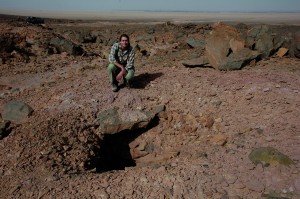MONDAY, 3 MAY 2010
“When the well is dry, we know the worth of water.” As I stood on the barren and parched Fezzan landscape even the idea of a well seemed far-fetched. Located in south-west Libya, the Fezzan is composed of desert broken by the occasional oasis. It is surprising, therefore, that Herodotus, writing in the 5th century BC, described this area as home to “a very great nation”, namely the Garamantes, a Saharan people in power until around 600AD.Only recently in human history, during the last 10,000 years in Mesopotamia, did agriculture and domestication become the dominant way of life. Permanent villages and crops demand a water supply; relatively easy if you’re living on the edge of the Nile, but the options are limited in the desolate, rocky and sandy landscapes found on the edges of the Saharan sand seas in North Africa.
The Garamantes solved this by harnessing groundwater. Foggaras (known as qanats, falajs or karez elsewhere) are subterranean systems of channels that tap into a groundwater supply and drain the water to the surface of the landscape further downslope. By tapping into a source at higher level and channelling the water, it is possible to distribute it to low-lying farming land. Standing on the surface of this landscape today, it is possible to see large heaps of spoil, the result of digging the shafts, spreading into the distance for kilometres on end. The precision with which foggaras were dug and the sheer effort needed to turn this barren landscape into a flourishing agricultural area, is something that even a modern engineer would be proud of.
Tracing foggaras and associated settlements and trying to make sense of their relative chronology is a challenge. Even in January, the midday sun beamed down as we walked from shaft to shaft taking key measurements. After years studying many hundreds of these shafts, Andrew Wilson, Professor of Archaeology of the Roman Empire at the University of Oxford, has unravelled not only the technical aspects of ancient water technology, but also its relationship to settlement and economic growth. “The combination of their slave-acquisition activities and their mastery of foggara irrigation technology enabled the Garamantes to enjoy a standard of living far superior to that of any other ancient Saharan society.”
To explore how the shafts were constructed and maintained, we descended inside. With harnesses and ropes attached to a wooden platform, we could move up and down the narrow shafts. The trickiest part was negotiating the loose rubble of the spoil heaps piled up around their entrances.
Upon easing your weight onto the rope, there is an immediate feeling of the walls closing in. At only one metre by half a metre wide, the sandstone shafts descend some 5 to 28 metres in depth, sometimes corkscrewing round in the process. Occasionally the solid sandstone walls are interspersed with bands of water-rolled gravels, but most notable are the rock-cut footholds. Vertically aligned and spaced at regular intervals, these would have been used by workers to access the channel below.
The horizontal channels were no longer accessible to us, blocked by hundreds of years of accumulated sand. Only the vertical foggara shafts remain. While in use, such obstruction would likely have been prevented by ‘sealing’ the shafts with huge slabs. Abseiling down these shafts, I found myself thinking about the slave labour and engineers managing these huge construction projects. The human presence in this landscape, although faded, is ever-present. At the top of some shafts are inscriptions; ancient graffiti. In addition, mud brick structures littered with pottery and grinding stones pay testament to the people who once made this hostile landscape their home.
As I climbed, tired and sandy, out of the last humid hole, it struck me how the foggaras stand as an emblem of the success of the Garamantes and also their doom. After extracting at least 30 billion gallons of water over 600 years, they discovered that exploiting an easily mined fossil supply comes at a cost. No matter how ingenious the water engineering system, a fossil supply, once depleted, is no more.
Djuke Veldhuis is a postdoc at the Leverhulme Centre for Human Evolutionary Studies

